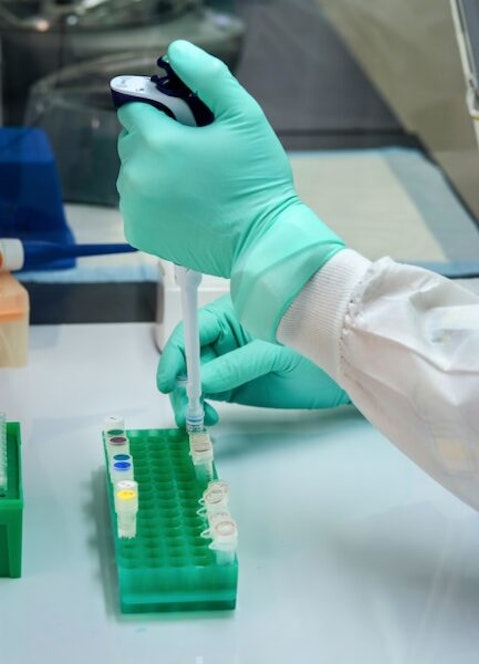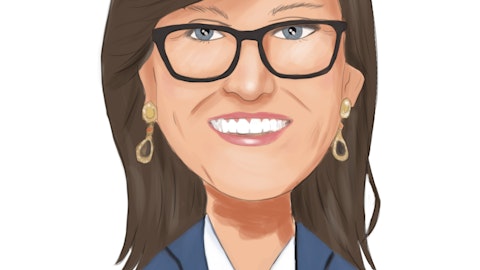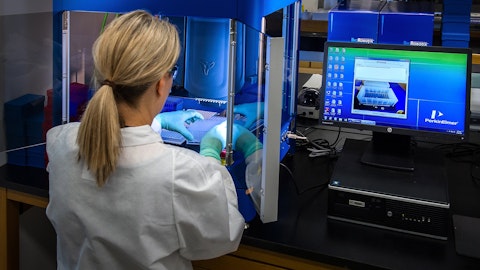Fate Therapeutics, Inc. (NASDAQ:FATE) Q4 2022 Earnings Call Transcript February 28, 2023
Operator: Welcome to the Fate Therapeutics Fourth Quarter 2022 Financial Results Conference Call. At this time, all participants are in a listen-only mode. This call is being webcast live on the Investors section of Fate’s website at fatetherapeutics.com. As a reminder, today’s call is being recorded. I would now like to introduce Scott Wolchko, President and CEO of Fate Therapeutics.
Scott Wolchko: Thank you. Good afternoon and thanks everyone for joining us for the Fate Therapeutics fourth quarter 2022 financial results call. Shortly after 4:00 p.m. Eastern Time today, we issued a press release with these results, which can be found on the Investors section of our website under Press Releases. In addition, our Form 10-K for the year ended December 31, 2022 was filed shortly thereafter and can be found on the Investors section of our website under Financial Information. Before we begin, I would like to remind everyone that except for statements of historical facts, the statements made by management and responses to questions on this conference call are forward-looking statements under the Safe Harbor provisions of the Private Securities Litigation Reform Act of 1995.
These statements involve risks and uncertainties that can cause actual results to differ materially from those in such forward-looking statements. Please see the forward-looking statement disclaimer on the company’s earnings press release issued after the close of market today as well as the risk factors including in our Form 10-K for the year ended December 31, 2022 that was filed with the SEC today. Undue reliance should not be placed on forward-looking statements, which speak only as of the date they are made as the facts and circumstances underlying these forward-looking statements may change. Except as required by law, Fate Therapeutics disclaims any obligation to update these forward-looking statements to reflect future information, events or circumstances.
Joining me on today’s call are Dr. Wayne Chu, our Chief Medical Officer; Ed Dulac, our Chief Financial Officer; and Dr. Bob Valamehr, our Chief Research and Development Officer. We will focus today’s discussion on recent developments that have impacted the company and our employees, including the termination of our collaboration agreement with Janssen as well as our reduction in headcount and operating expenses to extend cash runway. We will also discuss the outcome of our strategic review of our product candidate pipeline, where we elected to focus our resources on the advancement of our most innovative and differentiated off-the-shelf IPS-derived CAR NK and CAR T-cell programs. Finally, we will highlight our financial results for the fourth quarter 2022 as well as the key initiatives that we are prioritizing across our programs during 2023.
As I highlighted during our last quarterly call in early November, we were poised at that time to achieve several key milestones under our collaborations with ONO and Janssen. Indeed, several days later, at the SITC Annual Meeting, we announced that both ONO and Fate had exercised their respective options to co-develop and co-commercialize FT825, a multiplexed engineered CAR T-cell product candidate for solid tumors. This triggered a $12.5 million option exercise payment to Fate from ONO. Under the Janssen collaboration, Fate was authorized by Janssen in November to submit an IND application for a multiplex engineered IPSC-derived CAR NK cell product candidate for the treatment of B-cell lymphoma. That IND was allowed by the FDA in December and triggered a $3 million milestone payment to Fate from Janssen.
In addition, Janssen exercise a clinical development and commercialization option for its second antigen target, which triggered a $10 million milestone payment to Fate from Janssen. Given this positive momentum under the Janssen collaboration, we were disappointed to first learn in December that Janssen desired to significantly reduce its 2023 spending under the collaboration as well as modify certain key financial and intellectual property terms of our agreement. Unfortunately, we were not able to align with Janssen for continuation of our collaboration on revised terms. And Janssen exercised its right to terminate the agreement in early January. As a result, all research and development of collaboration candidates are being discontinued and we expect to complete the wind down of the collaboration in early April at Janssen’s expense.
As a consequence of the termination, we were required to significantly reduce our workforce and operating expenses. We also completed a strategic review of our product candidate pipeline and elected to prioritize the company’s most innovative and differentiated product candidates having the potential to address large unmet clinical needs. This strategic review resulted in most notably the discontinuation of our first generation FT596 CAR NK cell product candidate for the treatment of B-cell lymphoma. While our clinical experience with a three-dosed treatment schedule for FT596 was in its early stages, we made the strategic decision to prioritize the advancement of our second generation CD19 targeted CAR NK cell program, referred to as FT522.
FT522 incorporates 5 novel synthetic controls of cell function, designed to increase NK cell potency, enhance functional persistence and reduce or eliminate the need to administer conditioning chemotherapy to patients. Taken together, we believe FT522 has the potential to improve safety and clinical benefit, reach patients earlier in care, including in the community setting, and seamlessly combined with standard of care regimens, including those that contain CD20 as well as CD38 targeted monoclonal antibody therapies. Importantly, we also believe that novel synthetic controls integrated into 522 broaden the program’s potential therapeutic application to include both hematologic malignancies and autoimmune disorders. In the first quarter of 2023, we have reduced our workforce to approximately 220 employees in order to provide the necessary cash runway to achieve key clinical milestones across our prioritized IPS-derived CAR NK and CAR T-cell programs.
This was an exceptionally difficult and painful step. And we are greatly saddened to have had to move in this direction. Our employees continually demonstrated the highest level of dedication and commitment to our mission and we want to extend our deepest appreciation and wish them great success in the future. We are thankful that many of our employees have already found their next home within the thriving biotechnology communities of San Diego and San Francisco. Before I highlight the key program initiatives that we are focused on for 2023, I would like to turn the call over to Ed to discuss our financial results for 2022 and our expectations for the first quarter of 2023.
Ed Dulac: Thank you, Scott and good afternoon. Fate Therapeutics is in a strong financial position to advance our prioritized IPSC-derived CAR NK and CAR T-cell pipeline. Our cash, cash equivalents and investments at the end of the year, including net receivables from success-based milestones achieved in the fourth quarter, were approximately $475 million. In the fourth quarter of 2022, our revenue derived from our partnerships with Janssen and ONO Pharmaceutical increased significantly to $44.4 million compared to $17.1 million for the same period last year. We achieved multiple success-based milestones within our collaborations, which resulted in non-recurring revenue in the amount of $25.5 million in the quarter. Research and development expenses for the fourth quarter increased by $17.7 million to $87.2 million compared to $69.5 million for the same period last year.
The increase in our R&D expenses was attributable primarily to increases in employee headcount and compensation, including share-based compensation and expenses associated with sublicense fees and the use of third-party consultants. General and administrative expenses for the fourth quarter increased by $4.7 million to $21.6 million compared to $16.9 million for the same period last year. The increase in our G&A expenses was attributable primarily to an increase in employee headcount and compensation, including share-based compensation and legal fees. Total operating expenses for the fourth quarter are $108.8 million, which includes $19.4 million in non-cash share-based compensation expense. Note that in connection with the development of our off-the-shelf IPSC-derived CAR T-cell product candidate, FT819, we previously achieved the clinical milestone set forth in our amended license agreement with Memorial Sloan Kettering Cancer Center, which triggered a first milestone payment to MSK in 2021.
Up to two additional milestone payments maybe owed to MSK based on subsequent trading values of the company’s common stock ranging from $100 to $150 per share. We assessed the fair value of these contingent milestone payments currently valued at $3.9 million on a quarterly basis. In the fourth quarter, we recorded a non-cash $5.2 million non-operating benefit associated with the change in fair value. Our net loss for the fourth quarter was $56.4 million, or $0.58 per share. As we turn our focus to 2023, I want to share a few thoughts regarding the restructuring we announced on January 5 and how this will impact our GAAP financial results this year. In connection with the termination of the Janssen collaboration, in the first quarter of 2023, we expect to recognize as revenue $41.2 million that currently sits on our balance sheet as deferred revenue.
Additionally, expenses associated with closeout activities are expected to be reimbursed and will be recognized as revenue in the first quarter of 2023 as well. As previously announced, we have discontinued a number of earlier generation IPSC-derived NK-cell programs. While we expect a more focused pipeline to generate significant cost savings and operating leverage, the anticipated cost savings from a reduction in force are not likely to be realized until the second quarter of this year. We expect to incur charges of approximately $12 million to $16 million for severance and other employee termination related costs in the first quarter of this year. Additionally, we have many patients that remain on study for programs that have been discontinued.

Photo by CDC on Unsplash
This includes patients who were enrolled in our FT516 and FT596 clinical studies and continue to maintain an objective response. And we have elected to follow these patients for up to 1 year to assess durability of response. As a result, costs and support for the studies will dissipate over the course of the year. I would now like to turn the call back to Scott to discuss our key program initiatives for 2023.
Scott Wolchko: Thanks, Ed. As we look ahead to 2023, we have focused our operations on advancing our most innovative and differentiated IPS-derived CAR NK and CAR T-cell product candidates for patients with cancer and autoimmune disorders. And we have substantially reduced our expenses with the intent of providing the necessary cash runway to achieve key clinical milestones across our programs. We are now enrolling multi-dose treatment cohorts with FT576, our multiplex engineered CAR NK cell product candidate for multiple myeloma. In addition to its novel BCMA binder, FT576 also incorporates our proprietary high-affinity non-cleavable CD16 Fc receptor, which is designed to augment antibody dependent cellular cytotoxicity and enable combination with CD38 targeted monoclonal antibody therapy for dual antigen targeting of plasma cells.
Importantly, the potential for enhanced clinical activity in combination with a CD38 targeted monoclonal antibody therapy is enabled through the knockout of CD38, which eliminates the possibility of CD38 mediated fratricide. Despite the recent launch of two FDA approved BCMA targeted autologous CAR T-cell therapies, we believe an off-the-shelf multi-antigen targeted product candidate that is uniquely designed to synergize with CD38 targeted monoclonal antibody therapy may offer an attractive and differentiated value proposition. At the 2022 ASH Annual Meeting in December, we presented interim Phase 1 clinical data from the first 9 patients treated with a single dose of FT576 as monotherapy and in combination with CD38 targeted monoclonal antibody.
Clinical data from the single dose treatment cohorts in heavily pretreated patients showed encouraging clinical evidence of BCMA targeted activity and a favorable safety profile indicating the potential for administration in the outpatient setting. In particular, of the 3 patients treated with a single dose of FT576 in combination with CD38 targeted monoclonal antibody, at the first dose level of 100 million cells, 1 patient achieved a partial response. Notably, translational data from this combination cohort showed rapid and selective depletion of activated host immune cells through the first month of therapy. This suggests that CD38 targeted monoclonal antibody may also serve as a conditioning agent to mitigate the risk of rejection of FT576 and potentially reduce the need for administration of intense conditioning chemotherapy.
We are currently rolling two dose cohorts as monotherapy and in combination with CD38 targeted monoclonal antibody therapy at 300 million cells per dose. And upon clearance, we plan to open and assess three dose treatment cohorts, starting at 1 billion cells per dose. In keeping with our commitment to develop highly differentiated product candidates with the potential to address large unmet clinical needs, we are advancing our second generation CD90 targeted CAR NK cell program, referred to as FT522. Leveraging our unique ability to create multiplex engineered iPSC lines, FT522 incorporate 5 novel synthetic controls of cell function, designed to increase NK cell potency, enhance functional persistence and reduce or eliminate the need to administer intense conditioning chemotherapy to patients.
Notably, FT522 is the first product candidate to incorporate our proprietary alloimmune defense receptor or ADR technology. Our synthetic ADR receptor is designed to target 4-1BB expressing activated host immune cells and upon target engagement to potentiate the cell product via CD3-zeta signaling. Unlike cell engineering approaches that are designed to passively evade the host immune system, which do not obviate the need for intense chemotherapy conditioning to induce cell activation and functional persistence, our proprietary ADR technology is instead designed to feed off of the host immune system to promote its activity. We believe the design of FT522 has the potential to improve safety and benefit reach patients earlier in care, including in the community setting and seamlessly combined with standard of care regimens, including those that contain targeted monoclonal antibody therapies.
Importantly, we also believe the novel synthetic controls integrated into 522 broaden the program’s potential therapeutic application to include both hematologic malignancies and autoimmune disorders. At the 2022 ASH Annual Meeting in December, we presented preclinical data demonstrating that ADR armed iPS-derived CAR NK cells resist host mediated rejection, and in fact, expand, persist and maintain anti-tumor activity in the presence of alloreactive T-cells. These preclinical data provide proof-of-concept that at ADR-armed cell therapies have the potential to persist and induce potent anti-tumor activity without requiring intense conditioning chemotherapy. We intend to submit an investigational new drug application to the FDA in mid-2023 to commence a Phase 1 study of FT522 in combination with rituximab for the treatment of B-cell lymphoma, including without administration of intense conditioning chemotherapy to patients.
We are also particularly interested in expanding our clinical investigation of FT522 beyond oncology to autoimmunity, where recent publications have highlighted the potential of autologous CD19 targeting CAR T-cell therapy to induce drug-free remission in patients with certain severe autoimmune diseases. We believe this specific functional elements integrated into 522 may have the potential to engage and suppress the broad array of destructive drivers of autoimmune disease pathology, including auto antibody secreting T cells expressing CD19, auto antibody secreting plasma cells expressing CD38, and autoreactive and helper T-cells expressing 4-1BB. We are also excited with the progress of our iPS-derived CAR T-cell pipeline for the treatment of hematologic malignancies and solid tumors.
Dose escalation is continuing in our landmark Phase 1 study of our FT819 CD19 targeted CAR T-cell product candidate, which to our knowledge is the first ever T-cell product candidate manufactured from a clonal master iPSC line to undergo clinical investigation. FT819 incorporates several first of kind features, including the integration of a novel 1XX CAR construct into the TRAC locus, which is intended to promote uniform CAR expression, balance T-cell activation and exhaustion, and prevent graft-versus-host disease. We continue to believe a meaningful portion of the B-cell malignancy patient population will be unfit for autologous CAR T-cell therapy for numerous reasons, whether that be due to logistical barriers, prior therapy or disease aggressiveness, and these patients will require an effective off-the-shelf therapeutic alternatives.
At the 2022 ASH Annual Meeting in December, we presented interim clinical data from our ongoing Phase 1 study of FT819, which showed a favorable safety profile and demonstrated objective responses in heavily pretreated patients, including in patients who were not eligible for or had previously failed autologous CD19-targeted CAR T-cell therapy. Of the 8 patients with aggressive large B-cell lymphoma treated with a single dose of FT819 ranging from 90 million cells to 360 million cells, 2 patients were naïve to CAR T-cell therapy, one of whom achieved a complete response and 6 patients were previously treated with CAR T-cell therapy, 2 of whom achieved an objective response, including a complete response in a patient with DLBCL previously treated with 7 prior lines of therapy and who did not respond to autologous CD19 targeted CAR T-cell therapy.
Dose escalation is currently ongoing in single dose treatment cohorts at 540 million cell and B-cell lymphoma and at 180 million cells in chronic lymphocytic leukemia. Although autologous CAR T-cell therapy has shown significant efficacy in treating hematologic malignancies, its application to solid tumors has been hampered by several factors, including tumor-associated antigen heterogeneity and efficient CAR T-cell trafficking to the tumor and an immunosuppressive tumor microenvironment. Our multiplexed engineered iPS derived CAR T-cell product platform is designed to specifically address these challenges and enable the safe and effective treatment of solid tumors. Under our collaboration with ONO, we are conducting IND-enabling activities for FT825 on multiplexed engineered iPS-derived CAR T-cell product candidate targeting HER2-expressing solid tumors.
The product candidate incorporates 7 novel synthetic controls, designed to enhance effector cell function and overcome unique challenges in treating solid tumors. At the SITC 37th Annual Meeting held in November, we presented preclinical data of FT825, which highlighted the differentiated targeting profile of the product candidate’s novel HER2 targeted binding domain as well as the functional activity of the product candidate’s novel synthetic control, including to promote cell trafficking, redirect immunosuppressive signals in the tumor microenvironment, and induce T-cell activation. We expect to submit an IND application to the FDA in 2023 to commence a Phase 1 study of FT825 for patients with HER2 positive solid tumors under our ONO collaboration.
While it certainly has been a difficult 2 months and these continued to be challenging time for the biotechnology sector, I would like to conclude by thanking the employees of Fate Therapeutics. We are pioneers, the first to develop off-the-shelf iPS-derived cellular immunotherapy. We are resilient, embracing uncertainty and forging ahead. And we remain passionate and committed to leveraging our proprietary iPSC product platform and bringing highly differentiated product candidates to patients with the potential to transform outcomes and change lives. Thank you. I would like to now open the call to any questions.
See also 10 Best Stocks to Buy for High Returns and 12 Biggest Port Terminal Operators in the World.
Q&A Session
Follow Fate Therapeutics Inc (NASDAQ:FATE)
Follow Fate Therapeutics Inc (NASDAQ:FATE)
Operator: Thank you. Our first question comes from Tyler Van Buren with Cowen. Your line is open.
Unidentified Analyst: Hi, guys. This is Cara on for Tyler. So just wondering if you guys can tell us when you plan to present the next dataset for 576 and 819. Would that be at ASH or you thinking an investor event? Thanks.
Scott Wolchko: Thanks for the question. I think it’s a little too early us to commit to the data update around both of those programs. We are currently working with the modified team at Fate Therapeutics to target and focus our enrollment on the dose cohorts that I specifically mentioned during our call. I think in a couple months, we will be able to give a specific update with respect to the timeline for a data disclosure, whether that be at ASH or an investor event.
Operator: Our next question comes from Yigal Nochomovitz with Citi. Your line is open. My apologies.
Carly Kenselaar: Hi, this is Carly on form Yigal. Thanks for taking our questions. We wanted to ask about FT576 as well. We just wanted to get your updated thoughts on the competitive positioning. I guess, should we be thinking about the BCMA bispecifics of the bar from an efficacy perspective. And you mentioned you started to enroll in the multi-dose cohorts and I know it’s still relatively early, but just curious when you think you may have enough data to really understand the profile and be able to make a go no-go decision on a registrational pathway? Thanks very much.
Wayne Chu: Sure. Sure. I think as we have seen with NK cells with our other programs, I think a three-dosed schedule of NK cells is going to be important to create the right area under the curve, if you will, with respect to cell load to most effectively attack the tumors. And so we are completing a two dose schedule right now with FT576 as a monotherapy and in combination with CD38 at 300 million cells. Once that dose those dose cohorts clear, we will move to the three-dose schedule at 1 billion cells per dose. So this year, we certainly believe we will be dosing at a more optimized NK cell optimized treatment schedule for NK cells using three doses and at higher doses. And importantly, we are assessing the potential to combine with daratumumab which we have seen released in early translational data that we have seen sort of the dampening if you will of the alloreactive T-cell compartments when delivered in combination with the monoclonal antibody.
I think in terms of the competitive landscape, look, I think what we have seen so far is that unfortunately, in multiple myeloma, there are no curative therapies. There will continue to be patients that will progress through multiple lines of therapy. I think the BCMA is emerging. It appears to be a more durable target. So I do think there will be multiple lines of BCMA targeting therapy. That said, I think was an off-the-shelf platform, the whole promise of an off-the-shelf platform is to be able to reach patients early on care in the community setting, where most myeloma patients are treated and ideally to deliver and plug into a standard monoclonal antibody regimen with CD38 without intense chemotherapy conditioning. And so ultimately, our objective with 576 is to develop a highly differentiated product candidate that synergizes with CD38-targeted math that can be delivered early and often to patients as part of the standard chemotherapy regimen.
Operator: Thank you. Our next question comes from Daina Graybosch from SVB Securities. Your line is now open.
Daina Graybosch: Yes, I wonder if you could talk a little bit more about the 4-1BB targeted ADR for FT522, you say through several conferences last year published a lot of other interesting stealth edits, some passive, some active. And I wonder why go and prioritize the first clinical program with just ADR versus some of the other edits or a combination of edits?





